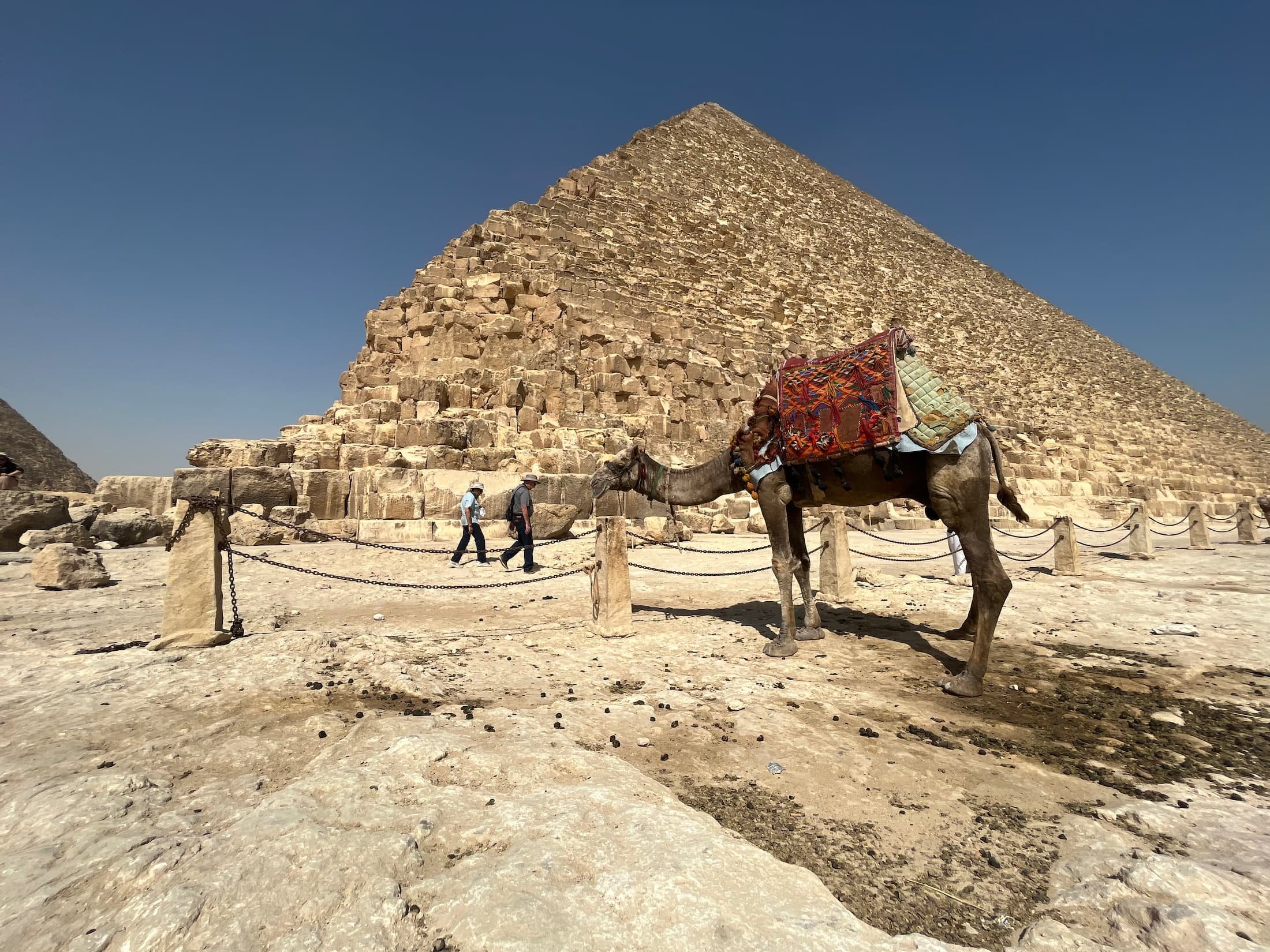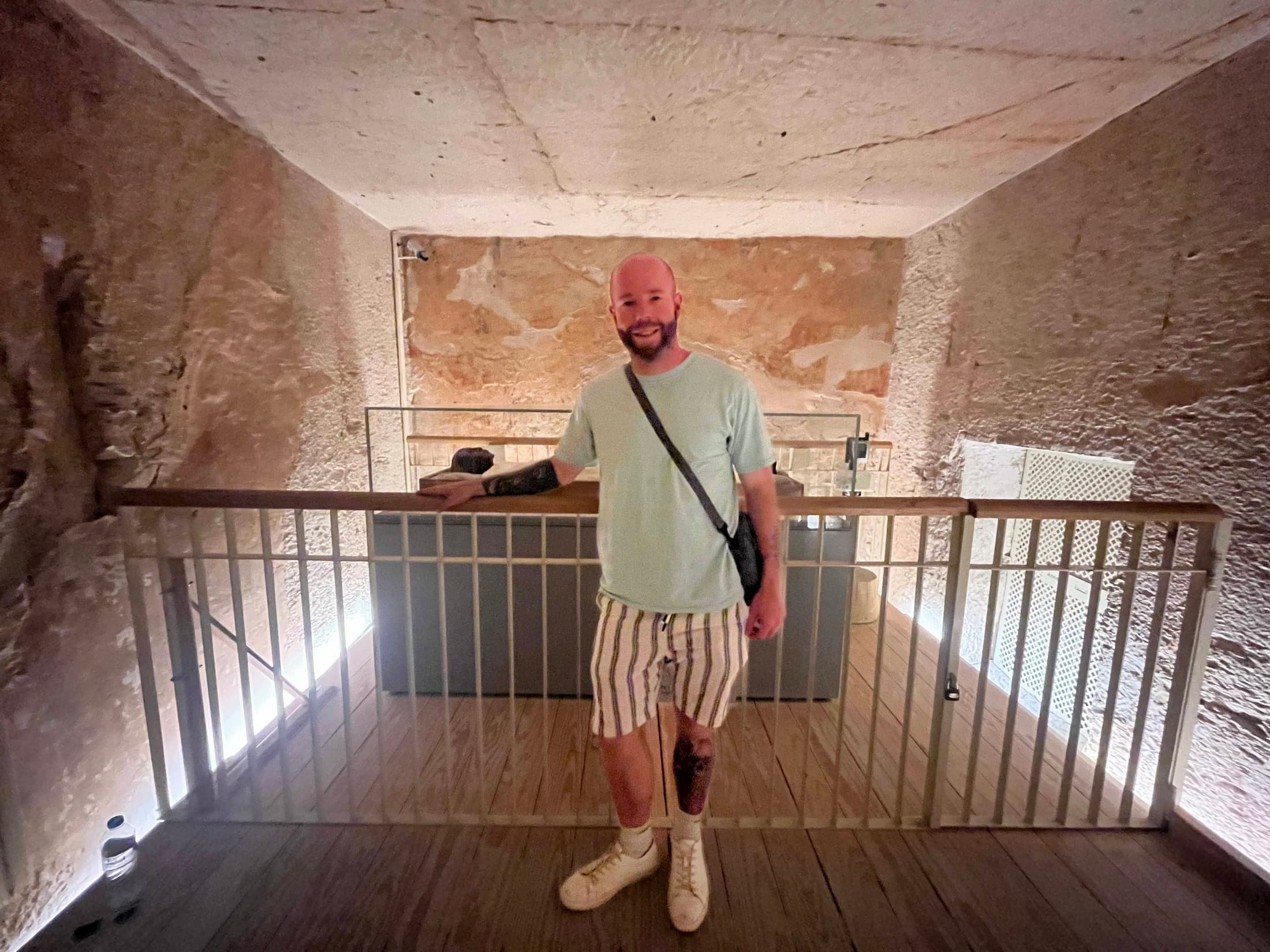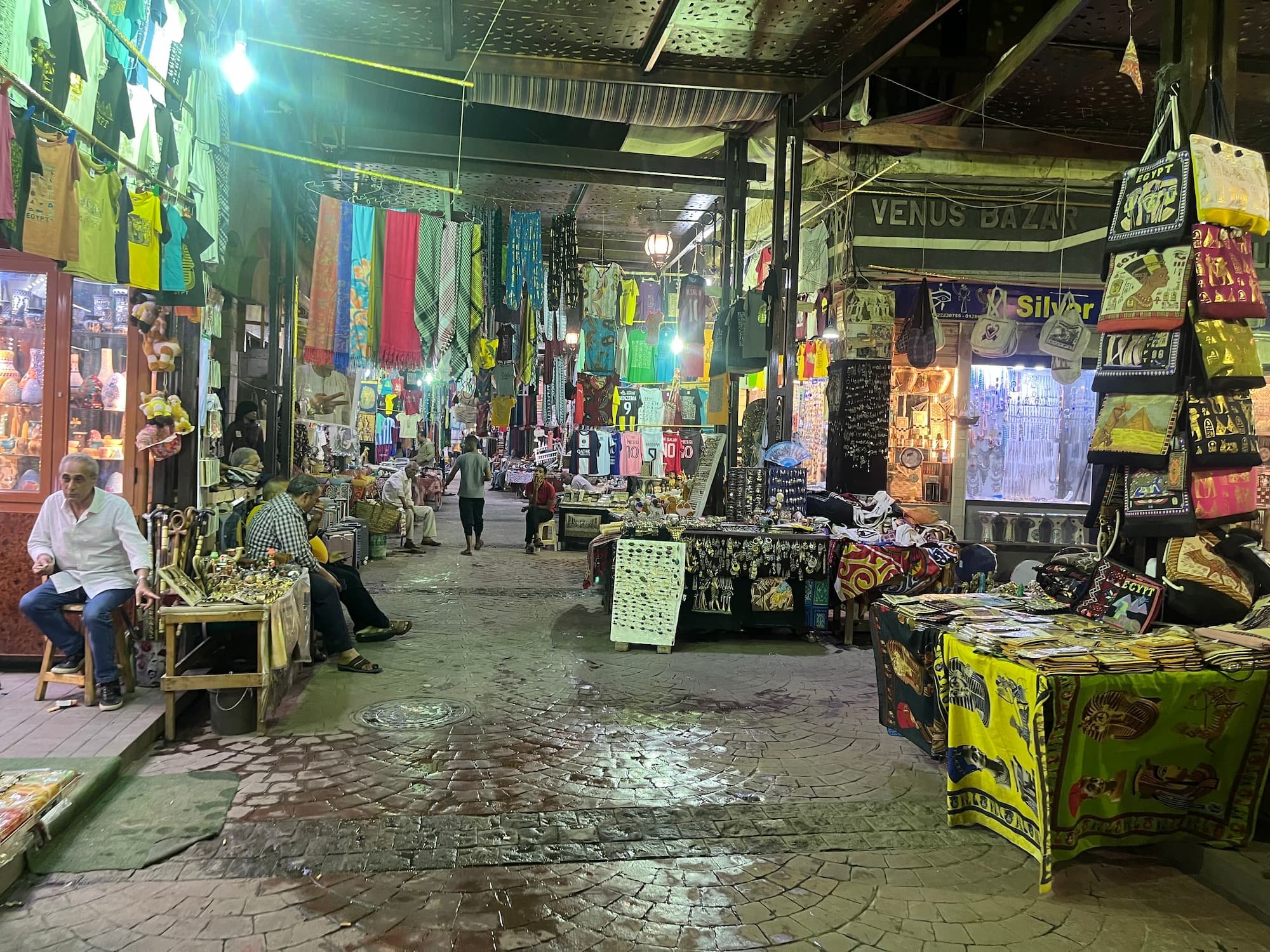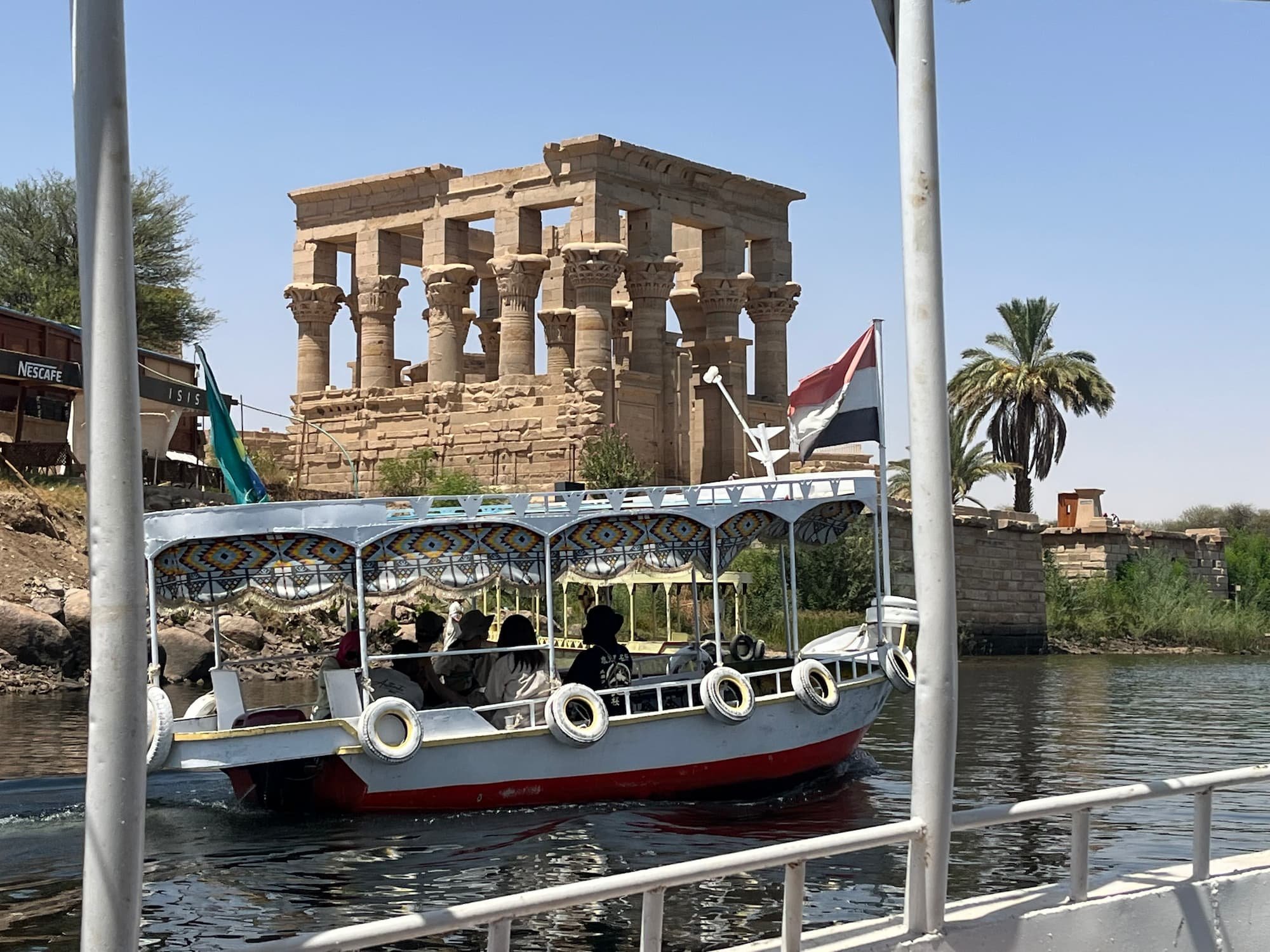100 Facts about Ancient Egypt to know before your trip.
Visiting Egypt soon and want to know its grand history?
Or maybe, you just want to get ahead in the quizzes with your friends.
My solo adventure through Egypt was an experience to say the least.
The good, the bad and the ugly, but turning these facts from imagination to reality at the most famous sites in Egypt is an awesome way to walk with the pharaohs, and to marvel at the pyramids.
Here are 100 facts about ancient Egypt you should know when visiting its popular cities.
The Great Pyramid of Giza.
Life and Society:
Nile River Lifeline: The Nile River was the lifeblood of ancient Egypt, providing water, fertile soil, and transportation.
Hierarchical Society: Pharaohs were considered gods, followed by nobles, priests, farmers, artisans, and slaves.
Mummification: Egyptians believed in preserving the body for the afterlife, hence the elaborate mummification process.
Hieroglyphics: Their intricate writing system used pictures and symbols to represent sounds and words.
Makeup Mania: Both men and women wore kohl for beauty and sun protection, and green eye makeup symbolised rebirth.
Cat Craze: Egyptians revered cats as protectors and even worshipped Bastet, a cat-headed goddess.
Cleopatra's Reign: Cleopatra VII, the last active pharaoh, ruled for 22 years and was known for her intelligence and political cunning.
Bread and Beer: Egyptians ate mainly bread, vegetables, and fruits, and enjoyed beer brewed from barley.
Games and Leisure: Senet, a board game similar to checkers, and music were popular forms of entertainment.
Medical Marvels: They set bones, treated wounds with honey, and used herbs for various ailments.
A mummified baboon in a museum in Luxor.
The Mummifcation Museum in Luxor is a great place to see some juicy mummies, ranging from high statues people, to baboons and crocodiles.
It is like something from a horror movie!
Mummification Museum practical information:
Opening times - 9 am–2 pm, 5–10 pm Daily.
Entrance fee - 140 EGP (£3.55).
Pharaohs and Pyramids:
Great Pyramid of Giza: The largest pyramid, built for Pharaoh Khufu, is estimated to have taken 27,000 workers 27 years to construct.
Pyramid Theories: Theories about how the pyramids were built range from ramps and levers to water transport and inclined planes.
Hidden Chambers: The Great Pyramid contains hidden chambers, including the King's Chamber and the Queen's Chamber.
Curse of the Pharaohs: The myth of a curse protecting tombs arose from the discovery of disturbed burial chambers.
Valley of the Kings: Located near Luxor, this valley holds the tombs of many pharaohs, including Tutankhamun.
Golden Mask of Tutankhamun: The iconic gold mask of Tutankhamun, discovered in 1922, is a masterpiece of ancient craftsmanship.
Hatshepsut: One of the few female pharaohs, Hatshepsut ruled successfully for 22 years and commissioned impressive temples.
Akhenaten's Revolution: Pharaoh Akhenaten attempted to establish a monotheistic religion centred around the sun god Aten.
Ramses the Great: A powerful warrior and builder, Rameses II expanded Egypt's empire and left behind numerous monuments.
Cleopatra's Tomb: The final resting place of Cleopatra remains undiscovered, adding to the mystery of her life and death.
Posing with King Tut.
King Tut’s juicy mummy.
The Valley of the Kings is home to many tombs of important pharaohs, but none more so than King Tutankhamun - the most famous of them all! You can visit his 3300 year old mummy for an extra cost, and believe me, it is worth every penny!
Visiting King Tutankhamun’s tomb practical information:
Opening times - 6 am to 4 pm. Monday to Sunday.
Entrance fee - 600 EGP (£15).
Religion and Mythology:
Polytheistic Beliefs: Egyptians worshipped over 2,000 gods and goddesses, each representing different aspects of nature and life.
Osiris and Isis: The myth of Osiris, god of the afterlife, and Isis, his sister-wife, is a central story in Egyptian religion.
Anubis: The jackal-headed god Anubis guided souls through the afterlife and presided over mummification.
Book of the Dead: This collection of spells and rituals aimed to help the deceased navigate the underworld and achieve eternal life.
Animal Deities: Animals like cows, crocodiles, and falcons were revered and associated with specific deities.
Temples and Offerings: Temples served as centres of worship and housed statues of gods and goddesses receiving offerings.
Festivals and Celebrations: Egyptians held vibrant festivals throughout the year, often connected to agricultural cycles and religious events.
Sun Worship: Ra, the sun god, was a major deity associated with creation, life, and rebirth.
Judgement of the Dead: According to belief, the deceased faced a trial to determine their fate in the afterlife.
Mummification as Transformation: The mummification process was seen as a way to transform the body into a vessel for the soul's journey.
Crocodiles are sacred animals in Aswan.
Aswan is a beautiful city in Egypt with a twist, as the taste of Nubia offers a charming vibe which is unmatched throughout Egypt. If you want to really feel the magic, then you should stay with a Nubian family, and visit the famous Nubian villages.
You are guaranteed some peace and quiet in Aswan, which makes it a popular choice for international visitors.
Visiting a Nubian Village practical information:
Opening times - all day, everyday.
Tour costs - 1350 EGP (£35).
Art and Architecture:
Pyramids as Tombs: Pyramids were not just tombs but also symbolic mountains connecting the earthly realm with the heavens.
Sphinxes: Guardian figures with lion bodies and human heads were often placed near temples and tombs.
Hieroglyphics in Art: Hieroglyphs adorned temple walls, tombs, and objects, telling stories and recording history.
Colourful Statues and Paintings: Egyptian art featured vibrant colours, detailed figures, and
Jewellery and Fashion: Egyptians loved intricate jewellery made from gold, gemstones, and glass, and adorned themselves with wigs, beads, and kohl.
Furniture and Household Goods: They made furniture from wood and reeds, and used pottery, baskets, and metal tools for daily life.
Music and Instruments: Harps, lutes, drums, and sistrums were popular instruments used for religious ceremonies and entertainment.
Hieroglyphics in Writing: Hieroglyphs were not just for art but also formed the basis of their writing system for religious texts, historical records, and literature.
Temple Design and Symbolism: Temples were built with symbolic elements like obelisks, sphinxes, and intricate carvings to represent the divine realm.
Original hieroglyphics on columns in the Medinet Habu Temple.
Luxor is a treasure trove of a city, situated 400 miles south of Cairo.
It is home to some of the best temples in Egypt, which all offer a unique story, along with some picture-perfect settings!
If you are feeling adventurous, then taking the sleeper train down to Luxor is a great travel experience - although a tad crazy!
Some Temples in Luxor you have to visit:
The popular Luxor tours cover all of these temples.
Science and Technology:
Calendar and Astronomy: Egyptians developed a 365-day calendar based on the Nile's flooding cycle and had advanced knowledge of astronomy.
Mathematics and Geometry: They used sophisticated math for surveying, construction, and pyramid building, and understood geometric principles.
Medicine and Surgery: They set bones, performed basic surgeries, and used medicinal herbs for various ailments.
Irrigation and Agriculture: They developed advanced irrigation systems to maximise crop yields and mastered techniques for farming in the desert.
Shipbuilding and Navigation: Egyptians built sturdy ships for trade and transportation on the Nile and the Mediterranean Sea.
Early Papermaking: They made papyrus, a type of paper from reeds, used for writing scrolls and preserving records.
Cosmetics and Perfumes: Egyptians created a variety of cosmetics and perfumes from natural ingredients like oils, plants, and minerals.
Glassblowing and Metalworking: They mastered glassblowing techniques and were skilled in crafting jewellery, tools, and weapons from bronze and gold.
Embalming Techniques: The elaborate mummification process involved removing organs, using natron salts for dehydration, and wrapping the body in linen.
Astronomical Alignments: Pyramids and temples were often aligned with celestial bodies like stars and solstices.
Medical Treatments: They used honey for wound healing, castor oil as a laxative, and willow bark for pain relief.
The lively Luxor Market.
You can find many items which are from ancient times in the souks. Spices, papyrus, and tea are a few items that I enjoyed buying.
Luxor Market is a great place to observe the ancient traditions which are still very much a part of modern life. If you are on a Cairo city break, then the khan el khalili bazaar is the most famous market in Egypt.
Luxor Market:
Opening times - 8am - 12pm daily.
Beyond the Nile:
Trade and Diplomacy: Egyptians traded with neighbouring kingdoms like Nubia, Punt, and the Near East for resources and luxury goods.
Military Power: They built strong armies, used chariots and bows and arrows effectively, and expanded their empire during certain periods.
Foreign Influences: Greek and Roman cultures later influenced Egyptian art, architecture, and religion.
Cleopatra's Rome Ties: Cleopatra formed alliances with Julius Caesar and Mark Antony, playing a significant role in Roman politics.
Egyptian Legacy: The impact of ancient Egypt is evident in art, architecture, literature, mathematics, and our understanding of civilization.
The Iconic Temple of Philae in Aswan.
Some Iconic Landmarks for you to add to your Egypt itinerary:
Pyramids of Giza.
Coptic Cairo.
Luxor Temple.
Karnak Temple.
Abu Simbel.
Myths and Legends:
Mythical Creatures: Egyptians believed in creatures like sphinxes, phoenixes, hippopotamuses with magical powers, and gods with animal heads.
The Eye of Horus: This symbol representing healing, protection, and royal power was often used in amulets and artwork.
Scarab Beetles: Revered for their regenerative abilities, scarabs were associated with rebirth and the afterlife.
Canopic Jars: Organs removed during mummification were stored in four jars representing different gods and goddesses.
Amulets and Talismans: Egyptians wore amulets for protection, good luck, and connection to the gods.
The iconic Pyramids and Sphinx.
Daily Life and Customs:
Education and Scribes: Scribes, highly respected professionals, held a monopoly on literacy and were responsible for record-keeping and administrative tasks.
Sports and Games: Egyptians enjoyed wrestling, swimming, running, and board games like Senet and Mehen.
Music and Dance: Music played a vital role in religious ceremonies and celebrations, and dancers performed during festivals and rituals.
Food and Diet: Bread, barley, vegetables, lentils, and fruits were staples, while meat and fish were eaten on occasion.
Family Life: Children were valued and received education, families lived in simple mudbrick houses, and marriage was common.
Pets and Animals: Egyptians kept dogs, cats, monkeys, and birds as pets, while oxen and donkeys were used for farming and transportation.
Cleanliness and Hygiene: Egyptians placed importance on cleanliness, bathing regularly in the Nile, and using ointments and perfumes.
Entertainment and Leisure: Music, games, storytelling, and festivals provided entertainment, while wealthy Egyptians enjoyed hunting and boating.
Slavery: Although not as central as in some other societies, slavery existed in ancient Egypt, with prisoners of war and debt-slaves performing various tasks.
The Egypt flag flying high at the Citadel of Qaitbay in Alexandria.
Arts and Crafts:
Sculpture and Statues: Egyptians created lifelike statues of pharaohs, gods, and goddesses, often made from granite, basalt, and wood.
Jewellery and Fashion: They crafted intricate jewellery using gold, gemstones, faience, and glass beads, and adorned themselves with colourful wigs, clothing, and accessories.
Furniture and Household Goods: Homes featured wooden furniture, decorated pottery, colourful carpets, and baskets used for storage and transportation.
Musical Instruments: Harps, lutes, flutes, drums, and sistrums were popular instruments used for religious ceremonies, celebrations, and everyday entertainment.
Weaving and Textiles: Egyptians mastered weaving techniques, creating linen garments, tapestries, and wall hangings with intricate patterns and dyes.
Selfie at Luxor Temple.
Religion and Beliefs:
Temples as Religious Centers: Temples served as places of worship, offerings, and religious ceremonies, housing statues of gods and goddesses.
Animal Gods and Goddesses: Bastet the cat goddess, Thoth the ibis god of wisdom, and Sobek the crocodile god were among many worshipped deities.
Festivals and Celebrations: Egyptians held vibrant festivals throughout the year, often connected to agricultural cycles and religious events like Opet or Heb Sed.
Offerings and Rituals: Food, drinks, statues, and prayers were offered to deities for favour, protection, and a successful afterlife.
Mummification and the Afterlife: Preserving the body through mummification was crucial for Egyptians, who believed in an afterlife journey and reincarnation.
The oldest pyramid in the world at Saqqara.
Legacy and Influence:
Pyramids as Enduring Symbols: The pyramids remain iconic symbols of ancient Egypt's engineering prowess and connection to the divine.
Hieroglyphics and Deciphering: The decipherment of hieroglyphs in the 19th century unlocked a wealth of information about ancient Egyptian history, culture, and beliefs.
Art and Architectural Inspiration: Egyptian art and architecture continue to inspire artists, architects, and designers, influencing various artistic movements.
Mathematical and Astronomical Advancements: Their contributions to mathematics, geometry, and astronomy laid the foundation for future scientific developments.
Influence on Mythology and Culture: Egyptian myths and legends have influenced literature, movies, and artistic creations throughout history.
Enjoying Egypt’s most famous camel ride.
Interesting Tidbits:
Cleopatra's Knowledge of Languages: Cleopatra reportedly spoke nine languages, making her a skilled diplomat and politician.
Makeup Mishap: Some ancient Egyptian kohl contained lead, which could have been harmful to their health.
Cat Mummies: Egyptians mummified their beloved cats and even built cemeteries dedicated to them.
Pharaohs' False Beards: False beards were symbols of power and masculinity worn by male pharaohs during ceremonies.
Cleopatra's Suicide Theory: While the exact cause of Cleopatra's death is still debated, some believe she may have committed suicide by asp bite.
Final Facts:
Lost City of Akhetaten: The city built by Pharaoh Akhenaten, dedicated to Aten, was largely abandoned after his death and rediscovered only in the 20th century.
Unidentified Mummies: Many mummies remain unidentified, offering potential discoveries and insights into the lives of ordinary Egyptians.
Egyptian Museum in Cairo: Home to an extensive collection of artefacts, the Egyptian Museum in Cairo is a treasure trove for anyone interested in ancient Egypt.
Modern Egypt's Connection to the Past: Modern Egyptians hold a deep connection to their ancient heritage, with many cultural traditions and practices rooted in the past.
Continued Archaeological Discoveries: New discoveries continue to shed light on ancient Egypt, offering fresh perspectives on their history, technology, and daily lives.
The Great Sphinx - Enigmatic Guardian: This colossal limestone statue with a lion's body and human head sits guard at the Giza necropolis, overlooking the pyramids. Measuring 73 meters long and 20 meters high, it's one of the largest ancient sculptures.
Monumental Gift: These two obelisks originally adorned the entrance of the Temple of Luxor in Karnak, Egypt. Cleopatra VII gifted them to Rome in the 1st century BC, and they were later erected in different locations.
Rosetta Stone: Unlocking the Pas: This black basalt slab, discovered in 1799 by French troops, holds the key to deciphering hieroglyphics. It features inscriptions in three languages: hieroglyphic, Demotic, and Ancient Greek.
Want to explore the temples in Egypt?
The Temples in Egypt are very popular with visitors to Egypt.
If you want to take a journey into the past through the ancient civilisations, then planning your Egypt trip around visiting the famous temples is the best way to feel the might of the Pharaohs.
There are many iconic temples down the Nile, which should all be on your itinerary!
Disclosure: I sometimes use affiliate marketing. This will not cost you anything, but helps with my travel costs. I only recommend companies I use myself.















